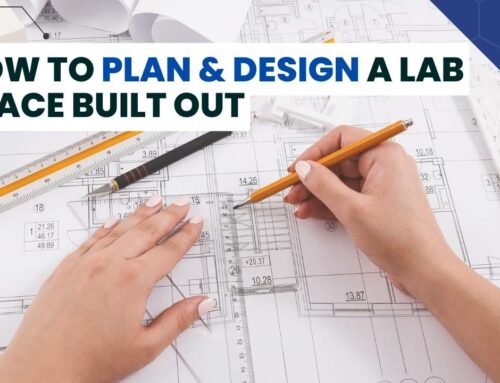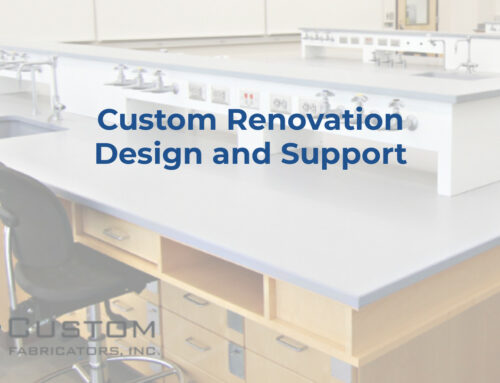The demands of the research industry are constantly evolving. Along with it, lab design for renovations or new builds also evolve. Following basic guidelines for modern laboratory design can help ensure your vision accounts for best practices and future needs. Keeping up with modern trends in 2022 and beyond will provide your lab with the opportunity to be more flexible and efficient.
What is a Laboratory Design?
Laboratory design refers to the arrangement and layout of a laboratory. Good design creates an environment that serves business or educational requirements, while also maximizing space and flexibility
- Do You Need a Consultant?
- Common Lab Layouts
- Generic Labs
- Flex Labs
- Sustainable Labs
- Collaborative Labs
- Wet and Dry
- Final Thoughts
Why is a Laboratory Design Important?
Optimal laboratories that are future-proof result from extensive planning, collaboration, and coordination between stakeholders and the design team. Design can also account for things like glassware washers, biosafety cabinets and air purifiers.
The smallest errors in design or choice of equipment can slow down construction, or have a negative impact on function and safety.
Do You Need a Laboratory Design Consultant?
A lab design consultant works with you to create a space that integrates form, functionality and aesthetics. Designers also bring relevant experience to optimize your space.
Specifically, they help:
- Review and offer opinions and recommendations on the best lab designs based on needs.
- Solve specific technical problems and provide product recommendations.
- Plan the reorganization of operations, supply, delivery and installation.
- Work with architectural engineers and design experts.
- Provide design work in CAD, Revit or SolidWorks.
Common Lab Flexibility Layouts
Lab designs have evolved to respond to changes in the environment and modern needs (such as social distancing). While modern labs need to be more responsive to current trends, they should also recognize changing future needs.
Generic Labs
As the name indicates, generic labs are built using a standardized layout and are all outfitted with the same furnishings. There tends to be an overlap between generic and flexible lab designs. Changes in personnel or use might occur in the future.
Flexible Labs
Flex lab design aims to be a canvass and provide a high degree of flexibility across multiple specialties. At the same time, it is important to avoid assumptions that can increase costs upfront without adding real value.
When executed properly, flexible lab designs allow low-cost modification and less disruption should needs change down the road. Modular casework and mobile workstations are great options for flex labs.
Sustainable Labs
Operating a dynamic and highly productive laboratory can be very expensive. Sustainable lab designs incorporate green business practices. For example, energy efficient equipment, process water efficiency, hazardous material handling, lab ventilation and more. A good way to help ensure sustainability is to follow the Labs21 Environmental Performance Criteria.
The EPC incorporates and extends the LEED™ Rating System for laboratory specific specific requirements.
Collaborative/Team-Based Labs
Trends in modern lab design indicate a shift towards collaborative scientific research in professional laboratory work environments. As a result, optimized open lab designs for multi-disciplinary, team-based collaborations and projects are in demand.
Lab designers are turning to a more open spaces concept: teamwork-oriented workstations. These foster cohesiveness within the lab and more collaboration with outside partners.
Team-based labs allow people from different areas of specialization to work together. This design is suitable for STEM-related institutes and universities. It is likely to be a fixture in private laboratories.
Wet and Dry Labs
Most research facilities utilize both wet and dry labs. Wet lab designs are suitable for research that includes chemicals, liquids and substances. Their design usually includes sinks, piped gases plumbing and fume hoods. They need chemical-resistant countertops, outside air, and mostly have fixed casework.
Dry labs focus on testing using computational analysis and computer intensive operations. Significant cabling for electrical and data are required. Isolation for vibration and ESD workbenches are also common. Dry labs tend to use mobile casework, adjustable shelving and plastic laminate countertops
Final Thoughts
Like any other major construction project, it is essential to establish the requirements and project goals at the onset. Clarity of the requirement and goals ensures the successful implementation of a design that best fits your needs.
Custom Fabricators Inc (CFI) has extensive experience in lab design and furnishing. We serve higher education, research, medical, municipal and industrial lab needs. CFI understands it’s imperative to provide high-quality, reliable products that are mobile, flexible and adaptable, and to provide unequaled value. The knowledge and commitment we offer is shared by our partners, affiliates and manufacturers.
We consistently deliver laboratory solutions fully-compliant to specific technical, cost, and schedule requirements. Contact us with any questions or for a quote.






